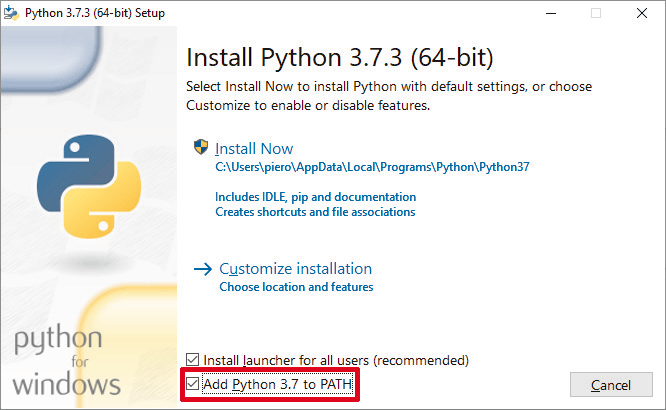
Type "help", "copyright", "credits" or "license" for more information.
#Python 3 install loc how to
How To Write Your First Python 3 Program 9.
#Python 3 install loc install
How To Install Python 3 and Set Up a Programming Environment on an Ubuntu 16.04 Server 8. If the Python 3.7.5 environment has been installed in the users OS before the libsqlite3-dev. libsqlite3-dev must be installed before the Python installation. How To Install Python 3 and Set Up a Local Programming Environment on CentOS 7 7. sudo apt-get install -y make zlib1g zlib1g-dev build-essential libbz2-dev libsqlite3-dev libssl-dev libxslt1-dev libffi-dev openssl python3-tk. Output: Python 3.9.1 (default, Jan 30 2021, 04:45:04) How To Install Python 3 and Set Up a Local Programming Environment on Windows 10 6. You are ready to execute our first program Python First Program execution. Now, our Python is up and running on MacOS. On success, you are going to receive a Python 3.9.1 interactive shell. Install latest python 3: brew install python Install latest python 3.x brew install python3. Launch the console and type the following command: $ python3.9 Output: /usr/local/bin/python3.9 Check version of Python To find the location of Python 3.9.1, type: which python3 ie Make altinstall protect from replacing the default python installed in /usr/bin/python. Here my computer has 4 core CPU.įinally to install binaries, run: $ sudo make altinstall The make altinstall command is recommended over make install because it does not overwrite the python3 binary. Note: You can specify the number of processor units or cores using -j option. Now, to compile and build Python 3.9.1 - which will take some time to complete, run: $ sudo make -j 4 Note: The above command makes the build process slower but advised to run it. Run the configure command with -enable-optimizations, which gives better performance in executing python code. If you are not root user, you should use sudo keyword every time installing Python package on your Linux system. Yum Package Manager (Redhat / RHEL / CentOS) Redhat / RHEL / CentOS Linux User should run the following command to install Python.

Then change the current directory to Python3.9.1 $ cd Python-3.9.1 It installs the latest Python version for both Python 3 and Python 2.

#Python 3 install loc archive
Unpack the archive with the help of the command shown below. Now, download latest source code of the Python using wget utility: $ sudo wget To install prerequisites dependencies, type: $ sudo apt install build-essential zlib1g-dev libncurses5-dev libgdbm-dev libnss3-dev libssl-dev libreadline-dev libffi-dev To download package information from all configured sources, type: $ sudo apt-get updateīefore proceeding with the installation of Python 3.9.1 from source, it is a must that you install the required libraries. The other way is to compile and install python 3.9.1 directly from the source. The execution of the above command produces the following output on console: /usr/bin/python3 Install Python 3.9.1 on Ubuntu 20.04 from Source The following command can help to identify the proper install location of Python: $ which python3 Now install python 3.9 using apt command: $ sudo apt-get install python3.9 $ sudo add-apt-repository ppa:deadsnakes/ppa


 0 kommentar(er)
0 kommentar(er)
